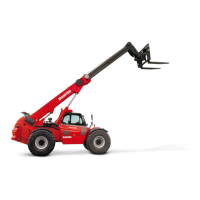1 - 15
D - LAYING A HIGH LOAD ON TIRES
- Approach the load in the transport position in front of the pile (Fig. L).
- Lift and extend the boom (1) (2) until the load is above the pile, if necessary
move the lift truck forward (3) (Fig. M) maneuvering very gently and carefully
(See E - VISIBILITY in chapter : HANDLING INSTRUCTIONS for visibility of
the road). Apply the parking brake and place the forward/reverse lever in
neutral.
- Place the load in a horizontal position and lay it down on the pile by lowering
and retracting the boom (1) (2) in order to position the load correctly (Fig.
N).
- Free the forks by alternately retracting and lifting the boom (3) (Fig. N) or, if
possible, by reversing the lift truck (3) (See E - VISIBILITY in chapter :
HANDLING INSTRUCTIONS for visibility of the road). Then bring the boom
into the transport position.
E - TAKING UP A NON PALLETIZED LOAD
- Tilt the carriage (1) forwards and extend the boom (2) while simultaneously
crowding the carriage backwards to slip the forks under the load (Fig. O). If
necessary, wedge the load.
F - N/A
G - HORIZONTAL POSITION OF THE LIFT TRUCK
Apart from the transverse slope of the ground, several parameters can upset
the horizontal position of the lift truck.
• The tire pressure.
• The stability of the ground.
• The balance of the load.
• Strong wind or stormy conditions.
O
N
M
L
WARNING
Under no circumstances should you lay down a load if the lift truck is not in
a horizontal position. (See paragraph G - HORIZONTAL POSITION OF
THE LIFT TRUCK).
WARNING
Before any handling work, check the points above and ensure that the lift
truck is completely horizontal.

